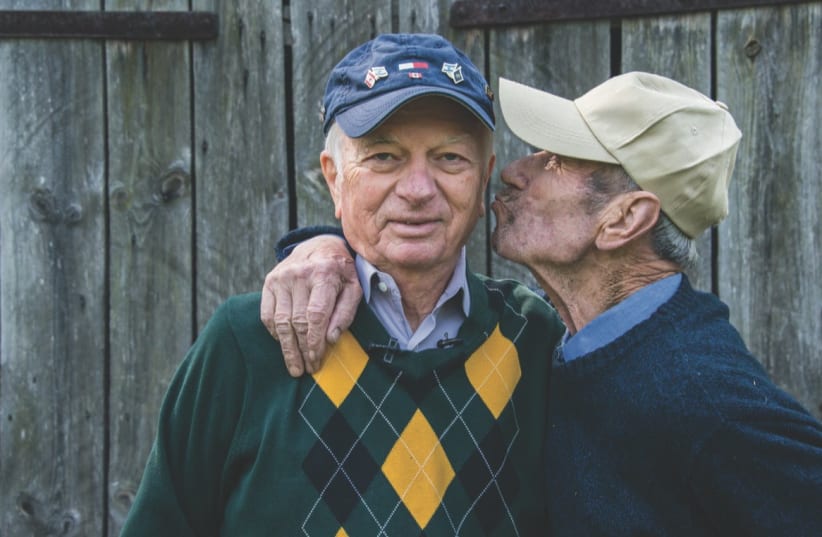Early in the powerful new documentary film, Saving the World Entire: Rescuers During the Holocaust, an elderly, white-haired woman, Czeslawa Zak, appears on camera. Speaking in Polish with English subtitles, she refers to what her late parents did during the Holocaust in risking their lives to save three Jewish families from the Nazis.
“It was just a normal human impulse,” says Czeslawa, who was a teenager when her family hid 14 Jews in their modest apartment in Warsaw. “It was obvious we had to save them.”
Sadly, tragically, incontrovertibly, saving Jews was not a ‘normal human impulse’ for most of humanity during World War II. In Europe, it was anything but ‘obvious’ to most people that they had to help Jews escape near-certain death at the hands of the Nazis

Among the miniscule minority of non-Jews who put their lives on the line to rescue Jews between 1939 and 1945, the film cites 10 by name. It tells four of their stories, including Czeslawa’s, highlighting Holocaust survivors who owe their post-war lives to these Righteous Among the Nations. That’s the honorific title the Yad Vashem World Holocaust Remembrance Center in Jerusalem gives to non-Jews who saved Jews in defiance of the Nazis who killed anyone found aiding Jews.
Directed by Naomi Wise and released in late January on International Holocaust Remembrance Day on I24 News, Saving the World Entire is only 24 minutes in length but its emotional impact is profound. Its title is derived from the Talmud which says, "Whoever saves a single life, saves the world entire.” That the film’s main focus is on events from between 78 and 84 years ago in no way diminishes its poignancy and relevance to today.
While the Holocaust will forever be one of the darkest chapters in human history, it also includes rare rays of light. While the genocidal depravity of the Nazi regime and its millions of willful collaborators will always be a searing indictment of the worst in human conduct, the bravery and moral fortitude of the too few who risked everything to save Jews represent the best in humanity.
Among the many moving moments in the film, two stand out in particular. The first involves Polish-born Holocaust survivor Sidney Zoltak who settled in Montreal after the war. Accompanied by a camera-crew, he travels with his son to the farm near the town of Siemiatycze in eastern Poland where the Krinski family hid Sydney and his family from the Nazis for 14 months. Sydney has an emotional reunion with Zigmund Krinski before showing his son the actual barn where Zigmund and his family concealed the Zoltaks in an underground bunker. For decades after the war, the Krinskis kept their act of bravery and altruism secret for fear of reprisals from neighbors for having saved Jews.
Later in the film, after learning about how Czeslawa Zak and her parents saved Jews during the war, we see Czeslawa arriving in Israel for the first time at age 86 to visit Olga Kost, one of those her Catholic family saved so long ago. She goes to Haifa for a highly touching meeting with Olga. Entering the apartment, she gives Olga a warm embrace and says to her, “We’ve managed to meet again in this world, and not in the other,” as the latter’s many grandchildren and great-grandchildren look on in wonderment.
The March of the Living organization, which produced the film, has long highlighted the actions of the Righteous in its programming, often having March participants meet with them during the annual week-long visit to Poland. Providing such inspiring role models relates to one of its main education goals to ensure that young people don’t despair about humanity.
Eli Rubenstein, International March of the Living’s Director of Education, who’s played a senior role in the program since its inception in 1988, lends his voice to the film. He describes a scene from the 2008 March, when thousands of young people at Auschwitz showed their deep appreciation for a Righteous after, Felix Zandman, one of the Jews she had saved 65 years earlier introduced her.
“All the people standing there applauded her, but not just once,” says Eli. “It came in waves. Time after time, just as the applause would die down, it rose again. It was as if the people there didn’t want to let go of that beautiful moment of hope, kindness and humanity. That’s when I realized how important it was on the March of the Living to always give our students hope by introducing them to one of the Righteous of the Nations. To understand that in the darkest of times, amidst all the terrible horrors visited by Nazi Germany on the Jewish people and others, there were still people who gave us reason to never give up hope in humanity.”
Robert Sarner is Senior Writer/Editor at Friends of the Simon Wiesenthal Center in Toronto. He previously worked as a journalist in Israel and France.
For a limited time, "Saving the World Entire" may be viewed on the websites of the International March of the Living (www.motl.org) and the USC Shoah Foundation (https://sfi.usc.edu). Both organizations provided archival footage for the film.
